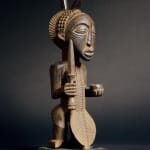Lulua Figure, 19th - 20th century
Wood
height 57.1 cm
height 22 1/2 in
height 22 1/2 in
MA.252
Further images
The Lulua people live at the crossroads of several major art-producing cultures: the Luba to the east, the Chokwe to the southwest, and the Kuba to the north. In contrast...
The Lulua people live at the crossroads of several major art-producing cultures: the Luba to the east, the Chokwe to the southwest, and the Kuba to the north. In contrast to the more public prestige-enhancing royal arts of their powerful neighbors, the arts of the Lulua in pre-colonial times were generally privately owned. Nonetheless, symbols of authority, such as ceremonial weapons, staffs of office and leopard-skin skirts, are seen on many of the figures. The hallmark of Lulua sculpture is a profusion of intricate scarification patterns that adorn the surface, preserving in sculpture a form of body art abandoned over a century ago. Lulua figures referred to ancestral spirits who bestowed protection, good fortune, and beauty on their devotees. During pregnancy and childbirth, women tucked the small half figures that end in a point into their wrappers or belts for protection; after the child was born, the standing figures were placed next to the baby's bed to keep the infant from harm. Small crouching figures, spectacularly poised as if in space, served as tobacco mortars, hemp containers, or amulets to be hung from hunters' belts.







